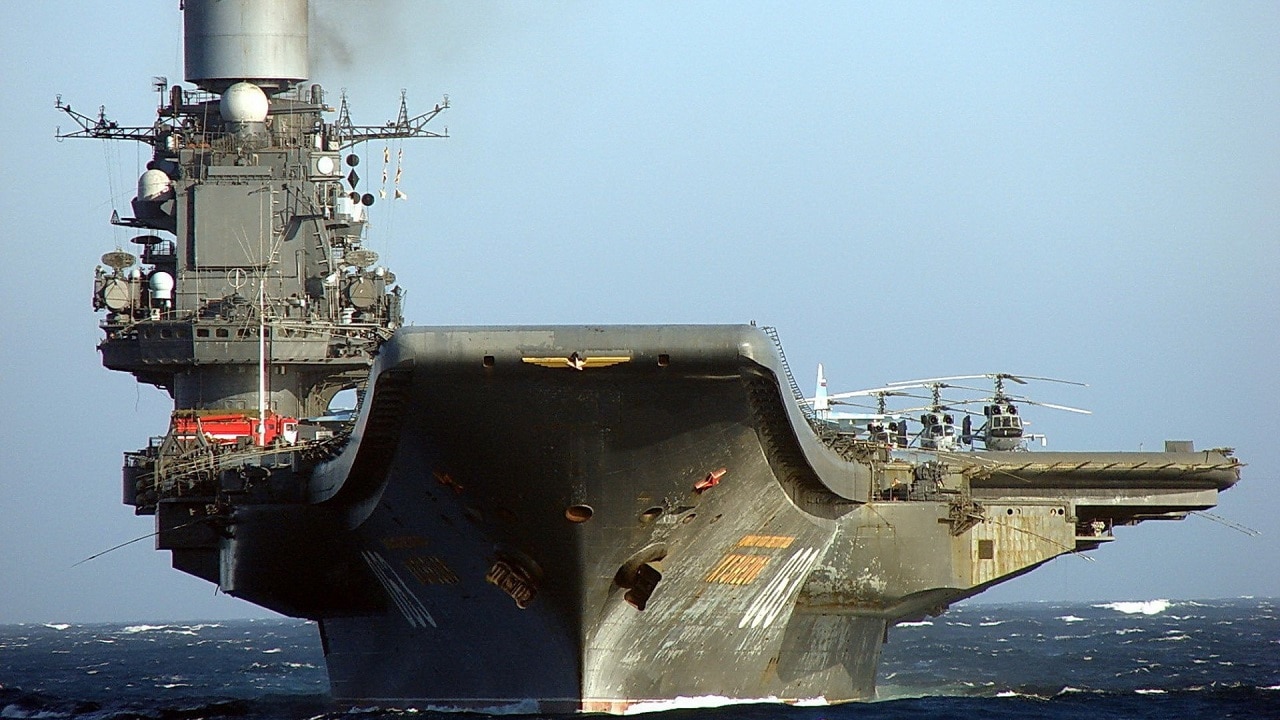Cursed Russian Aircraft Carrier Hopes to Return to Sea: Russia should just give up on this aircraft carrier and scrap it. The cursed Admiral Kuznetsov has finally left drydock, but that doesn’t mean it will ever take to the high seas.
Russia’s only aircraft carrier has endured more catastrophes than you would think is possible. It has caught fire more than once with deadly consequences. There have been numerous accidents and breakdowns, plus the dry dock has sunk, and aircraft have been lost to mishaps.
Admiral Kuznetsov: What’s Next for the Carrier?
Russia originally planned for the Admiral Kuznetsov to have a four year refit. It is now in year six of the project.
Vladimir Putin’s navy hopes it can be deployed in 2024, but that is optimistic. The Russian Navy believes the refit could add 10 to 15 years to its lifespan.
Again, that is not likely. The latest stroke of bad luck happened in January when the holds were filled with water, and the hull had a dangerous level of corrosion.
Substantial Work to Do
The carrier has left drydock but not under its own propulsion. It had to be towed.
So, good news about leaving, but bad news for its engines. The ship has eight turbo-pressured boilers and shipbuilders want to replace four and refurbish the rest.
Workers are recoating the flight deck. Modern air defenses are supposed to be installed. Plus, the vessel will have new electronic warfare systems, and communications, including intelligence and surveillance capabilities.
This was going to cost Russia’s United Shipbuilding Corporation a whopping $866 million. But Moscow only allocated half of that amount, and funds will likely be cut again due to the war in Ukraine. Russia should start over and build a new carrier at that cost.
More Details About the Carrier
The Admiral Kuznetsov dates back to 1982 when it was laid down and finished in 1991. It has spent most of its life in port due to the difficulty of maintaining it. The carrier is 1,000 feet long and displaces 58,000 tons. It is smaller than U.S. carriers and can conduct operations with only 24 airplanes. One advantage of the aircraft carrier is its P-700 Granit anti-ship missiles to overcome the shortage of attack airplanes.
The carrier made a deployment to Syria in 2016 that was somewhat successful – in that warship left port, that is. It had to be escorted by a tugboat in case it broke down. But flight deck operations were less than stellar. The ship lost two airplanes in three weeks due to accidents.
There was another fire in December of 2022. All workers were safe, but it was an embarrassment for the Russian navy. Even when steaming at sea, the carrier belches a dirty, heavy, and black smoke called mazut that makes the ship look unhealthy.
In 2019, there was a fire in the engine room from a welding accident and another two employees died. Fourteen suffered from smoke inhalation and burns. In 2018, a floating crane smashed the Kuznetsov’s deck in an accident that killed one worker and injured four others. There was even a case of embezzlement from the shipyard in 2021.
What’s Next for Russia’s Navy
The Russian Navy has a decision to make: continue work on the Admiral Kuznetsov or scrap it and try to build a new carrier. This would likely cost at least a billion dollars and ten years of work.
Moscow must take a hard look at the navy. The branch has not enjoyed a good war in Ukraine. It lost its Black Sea flagship Moskva to enemy missiles. The remaining ships only fire standoff missiles. The fleet never attacked Odesa, as some analysts predicted that it would. It is a green water navy only able to conduct operations in the Near Abroad close to home. The Syria deployment was a good try but its grade on the mission was probably only a “C-plus.”
It’s time for the Russians to re-imagine their navy and improve it to become a global maritime power. As it stands now, they aren’t, and the Admiral Kuznetsov, even if it sails again, will not change this state of affairs.
Author Expertise and Experience
Serving as 19FortyFive’s Defense and National Security Editor, Dr. Brent M. Eastwood is the author of Humans, Machines, and Data: Future Trends in Warfare. He is an Emerging Threats expert and former U.S. Army Infantry officer. You can follow him on Twitter @BMEastwood. He holds a Ph.D. in Political Science and Foreign Policy/ International Relations.

